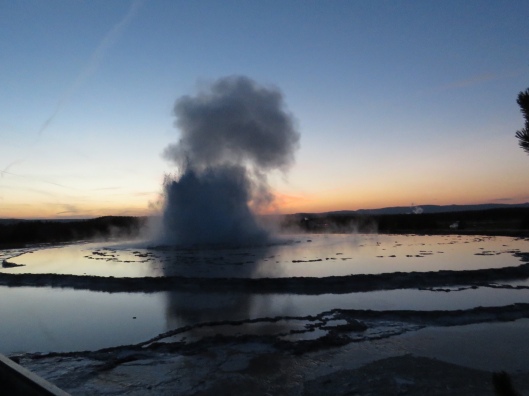Back in 1979 I worked in Yellowstone National Park. Because I lived in the employee dorms and ate at the employee cafeteria, I had few responsibilities outside of work. I spent most of my free time in the various geyser basins, watching geysers. I became a geyser gazer. I soon learned that there were others similarly fascinated and that we were welcome to report what we saw to the park visitors center where they (the rangers) kept records. They used our observations of past eruptions to predict when the next eruptions of the major geysers were going to be. I signed up as an official volunteer with the park.
Yellowstone has about half of the worlds known geysers, and many of those geysers are in the Upper Geyser Basin. A geyser is a hot spring which doesn’t just flow continuously. Rather, a constriction at depth causes pressure to build up underground as water turns to steam. The steam pushes water out to the surface. Once enough pressure has been relieved the superheated water underground flashes into steam which pushes more water out and this continues until the eruption is done- in minutes or hours.
Every geyser is different. They are truly individual.
Coming back to the geysers 39 years later, I find them as fascinating now as they were then. Being 39 years older, I find myself interested in my fascination. What is it that is so compelling about geysers.
As I walked around the geyser basins, what came to me is that geysers of any size are a full sensory experience. And the bigger the geyser the more intense the experience. Some geysers erupt to 300 feet- some to 3 feet. There are smells– often sulfurous and something else- like rain on hot pavement. There is movement– boiling and flowing and spurts of hot water and steam. There is tactile– the feeling of steam on your face- the warmth of the overflow water, the gentle rain as the steam condenses and rains out of the air. There are sounds– the whomp of a major burst- the splash as the water rains down- the roar of steam. There is the unexpected— every burst is different- some higher, some lower, changing direction as the wind shifts. There are often rainbows in the steam and mist. There is variety– each vent in a geyser has different behavior. Geysers involve the brain. Especially before the eruption much thought and discussion is given to watching the behavior of each vent to see what predicts imminent eruption. There is the pleasure of anticipating a natural event which cannot be either hurried or delayed by human desire.
Sadly little of this comes across in a photo. The anticipation of waiting, the sounds, the smells, the movement.
I am not alone in my fascination. GOSA (the Geyser Observation and Study Association) has an associated email list and publishes the annual Transactions.
A lucky few of the many visitors to the park are willing to sit patiently and wait for a major eruption like Great Fountain.

The eruption started about 50 minutes later. Here is the first burst against a post sunset sky.

In my few days in the park I was able to see several of the major geysers.
My favorite though was Lone Star. I was there at dusk alone and waited for the eruption. It was noisy and powerful and beautiful. For scale- the cone is about 15 feet high.


What a beautiful post. Thanks for sharing your evolving thoughts and your animated descriptions. I have not forgotten some of your Yellowstone stories from years ago.
LikeLiked by 1 person
I agree photos or videos do no justice. The anticipation is a key part for me. I once saw these beautiful spewers back in 1997 and certainly enjoyed the experience. It goes to another level with snow and coming of winter. Frozen waterfalls are also something to be seen. Yellowstone is a great place when it’s cold.
LikeLike
Someday perhaps I could be there in the winter. It sounds like an amazingvexperience
LikeLike